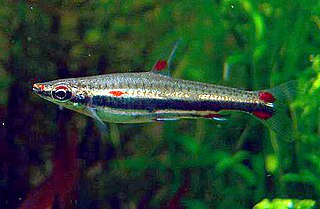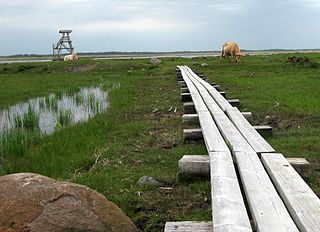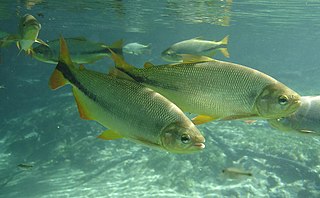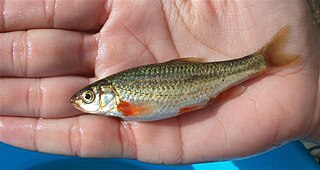
Poecilia is a genus of fishes in the family Poeciliidae of the order Cyprinodontiformes. These livebearers are native to fresh, brackish and salt water in the Americas, and some species in the genus are euryhaline. A few have adapted to living in waters that contain high levels of toxic hydrogen sulfide and a population of P. mexicana lives in caves.

Nannostomus,, is a genus of fish belonging to the characin family Lebiasinidae. All of the species in this genus are known as pencil fish, a popular name that was first only applied to two species in the 1920s, Nannostomus unifasciatus and Nannostomus eques. By the late 1950s, the term would come to be applied to all members of the genus. Several species have become popular aquarium fish due to their attractive coloration, unique shape, and interesting demeanor.

Leporinus is a genus of fish in the family Anostomidae native to South America. The fossil species Leporinus scalabrinii, known from the late Miocene of Entre Ríos in Argentina, has only recently been added to this genus after being misidentified as a species of primate under the name Arrhinolemur scalabrinii for over 100 years.

The wattle-necked softshell turtle, also commonly known as Steindachner's soft-shelled turtle, is an endangered Asian species of softshell turtle in the family Trionychidae. The species is the only member of the genus Palea.

Lake Engure Nature Park is a protected park in Latvia covering 197.62 km2 (76.30 sq mi), named for Lake Engure. It was designated as a nature spot in 1998.

Platycephalus is a genus of mostly marine, demersal ray-finned fish belonging to the family Platycephalidae. They are found in the eastern Mediterranean, the Indian Ocean and western Pacific Ocean.

Telestes is a genus of cyprinid fish. It was formerly usually included in Leuciscus.

Anaecypris hispanica, the Spanish minnowcarp, is a small species of ray-finned fish species in the family Cyprinidae. It is the only living member of the genus Anaecypris. It is endemic to the Iberian Peninsula and is found in the basin of the Guadiana River in southern Spain and Portugal. Its natural habitats are rivers and intermittent rivers which are shallow, highly oxygenated, have a water temperature of no more than 25 °C and have a coarse stream bed. It is threatened by habitat loss. They grow to a maximum size of 60mm and live for three years.
Squalius is a genus of fish in the family Cyprinidae found in Europe and Asia. Hybridization is not rare in the Cyprinidae, including this genus. S. alburnoides is known to be of ancient hybrid origin, with the paternal lineage deriving from a prehistoric species related to Anaecypris; the latter mated with ancestral S. pyrenaicus. Present-day S. alburnoides mates with sympatric congeners of other species.

Bathygobius is a circumtropical genus of fish in the family Gobiidae.

Brycon is a genus of fish in the family Characidae found in freshwater habitats in Central and South America, ranging from southern Mexico to northern Argentina. Despite not being closely related to true trout, they are sometimes called South American trout. Members of the genus may be referred to by a number of other different common names in various languages. They reach a maximum length of 11.9–79.5 cm (4.7–31.3 in) depending on the species involved. Some species perform seasonal breeding migrations.

Chirostoma is a genus of Neotropical silversides from the Lerma River basin in Mexico, including lakes Chapala and Pátzcuaro. Fish in the genus collectively go by the common name charal/charales in their native range. They are heavily fished, but several of the species have become threatened due to habitat loss, introduced species and overfishing. Three species are considered extinct: C. bartoni, C. charari (1957) and C. compressum (1900). Four others have not been recorded recently and may also be extinct.

Kneria is a genus of small fish in the family Kneriidae. All 13 species in this genus are restricted to Africa.
Luciobarbus is a genus of ray-finned fishes in the family Cyprinidae. Its members are found in fresh and brackish waters of southern Europe, northern Africa, the wider Near East, the Aral and Caspian Seas, and rivers associated with these. Several species in the genus are threatened. Most species are fairly small to medium-sized cyprinids, but the genus also includes several members that can surpass 1 m (3.3 ft) in length and the largest, the mangar can reach 2.3 m (7.5 ft).

Achondrostoma is a genus of freshwater fish in the family Cyprinidae, the carps and minnows. It is endemic to the Iberian Peninsula.

Pseudochondrostoma is a genus of cyprinid fish that occurs in the Iberian Peninsula.
Ptychobarbus is a genus of cyprinid fish that is found in rivers, streams and lakes in the Himalayas and Tibetan Plateau of China, India, Nepal and Pakistan, extending into the highlands of Afghanistan. They reach up to 2.2 kg (5 lb) in weight and about 65 cm (2.1 ft) in total length. They mostly feed on benthic invertebrates, but will also take planktonic organisms, aquatic plants and algae.

Pao is a genus of mostly freshwater pufferfish with one species also occurring in brackish water. They are found in Southeast Asia. Until 2013, its species were generally placed in Tetraodon.

Squalius valentinus, commonly known as the Valencia chub and the Levantine bagra, is a species of freshwater fish in the carp family Cyprinidae. It was first isolated from the Turia River in Valencia, hence its name. It is considered endangered. This species is differentiated from its cogenerates by having eight branched rays in its dorsal fin; eight branched rays in its anal fin; two rows of pharyngeal teeth on both sides possessing 2 and 5 teeth ; a wide caudal peduncle; its number of gill rakers; the number of scales in its lateral line; the number of scale rows above the latter; by possessing three scale rows below it; by having thirty-nine vertebrae ; showing large 4th and 5th infraorbital bones; a maxilla with a very distinct marked anterior process; exhibiting a frontal bone expanded at the middle; a wide neurocranium bone; the lower branch of the pharyngeal bone being robust; a large and narrow urohyal; as well as genetic differences (allozymes).

The wildlife of Finland is affected by prevailing environmental conditions. The phytogeography of Finland is shared between the Arctic, central European, and northern European provinces of the Circumboreal Region within the Boreal Kingdom. The territory of Finland can be subdivided into three ecoregions: the Scandinavian and Russian taiga, Sarmatic mixed forests, and Scandinavian montane birch forest and grasslands. Taiga covers most of Finland from northern regions of southern provinces to the north of Lapland. On the southwestern coast, south of the Helsinki-Rauma line, forests are mixed as is more typical in the Baltic region. In the extreme north of Finland, near the tree line and Arctic Ocean, montane birch forests are common.

















